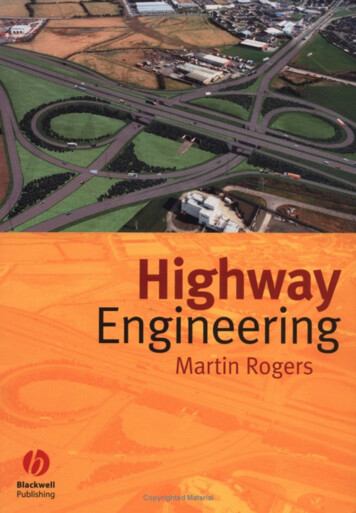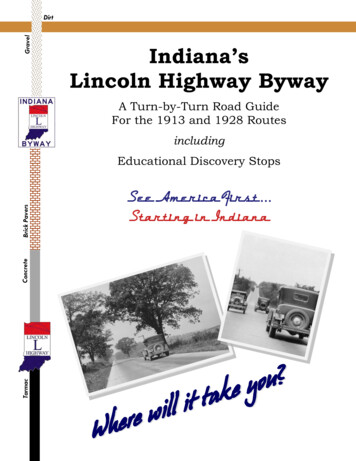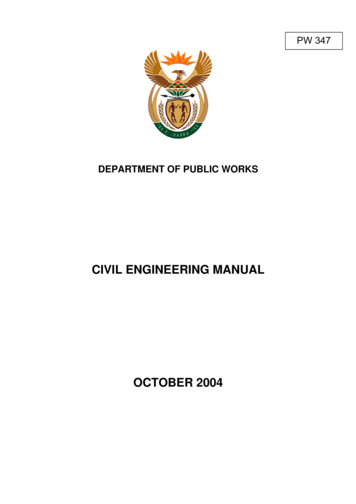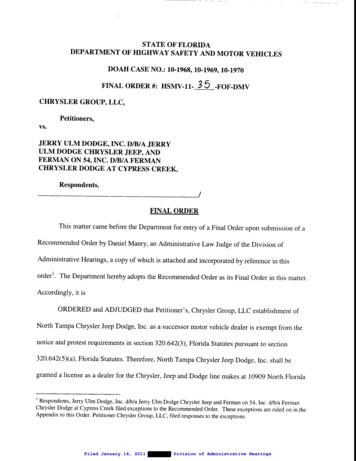
Transcription
HIGHWAY ENGINEERING
HIGHWAYENGINEERINGMartin RogersDepartment of Civil and Structural EngineeringDublin Institute of TechnologyIrelandBlackwellScience
To Margaret, for all her love, support and encouragement
2003 by Blackwell Publishing LtdEditorial Offices:9600 Garsington Road, Oxford OX4 2DQTel: 44 (0) 1865 776868108 Cowley Road, Oxford OX4 1JF, UKTel: 44 (0)1865 791100Blackwell Publishing USA, 350 MainStreet, Malden, MA 02148-5018, USATel: 1 781 388 8250Iowa State Press, a Blackwell PublishingCompany, 2121 State Avenue, Ames, Iowa50014-8300, USATel: 1 515 292 0140Blackwell Munksgaard, 1 Rosenørns Allé,P.O. Box 227, DK-1502 Copenhagen V,DenmarkTel: 45 77 33 33 33Blackwell Publishing Asia Pty Ltd,550 Swanston Street, Carlton South,Victoria 3053, AustraliaTel: 61 (0)3 9347 0300Blackwell Verlag, Kurfürstendamm 57,10707 Berlin, GermanyTel: 49 (0)30 32 79 060Blackwell Publishing, 10 rue CasimirDelavigne, 75006 Paris, FranceTel: 33 1 53 10 33 10The right of the Author to be identified as the Authorof this Work has been asserted in accordance with theCopyright, Designs and Patents Act 1988.All rights reserved. No part of this publication maybe reproduced, stored in a retrieval system, ortransmitted, in any form or by any means, electronic,mechanical, photocopying, recording or otherwise,except as permitted by the UK Copyright, Designsand Patents Act 1988, without the prior permissionof the publisher.First published 2003A catalogue record for this title is available from theBritish LibraryISBN 0-632-05993-1Library of CongressCataloging-in-Publication DataRogers, Martin.Highway engineering / Martin Rogers. – 1st ed.p. cm.ISBN 0-632-05993-1 (Paperback : alk. paper)1. Highway engineering. I. Title.TE145.R65 2003625.7 – dc212003005910Set in 10 on 13 pt Timesby SNP Best-set Typesetter Ltd., Hong KongPrinted and bound in Great Britain byTJ International Ltd, Padstow, CornwallFor further information onBlackwell Publishing, visit our website:www.blackwellpublishing.com
ContentsPreface, xiiiAcknowledgements, xv1The Transportation Planning Process, 11.1 Why are highways so important? 11.2 The administration of highway schemes, 11.3 Sources of funding, 21.4 Highway planning, 31.4.1 Introduction, 31.4.2 Travel data, 41.4.3 Highway planning strategies, 61.4.4 Transportation studies, 71.5 The decision-making process in highway and transport planning, 91.5.1 Introduction, 91.5.2 Economic assessment, 101.5.3 Environmental assessment, 111.5.4 Public consultation, 121.6 Summary, 131.7 References, 142Forecasting Future Traffic Flows, 152.1 Basic principles of traffic demand analysis, 152.2 Demand modelling, 162.3 Land use models, 182.4 Trip generation, 192.5 Trip distribution, 222.5.1 Introduction, 222.5.2 The gravity model, 232.5.3 Growth factor models, 262.5.4 The Furness method, 272.6 Modal split, 312.7 Traffic assignment, 342.8 A full example of the four-stage transportation modelling process, 36
viiiContents2.8.1 Trip production, 362.8.2 Trip distribution, 372.8.3 Modal split, 402.8.4 Trip assignment, 412.9 Concluding comments, 422.10 References, 433Scheme Appraisal for Highway Projects, 443.1 Introduction, 443.2 Economic appraisal of highway schemes, 453.3 Cost-benefit analysis, 463.3.1 Introduction, 463.3.2 Identifying the main project options, 463.3.3 Identifying all relevant costs and benefits, 483.3.4 Economic life, residual value and the discount rate, 503.3.5 Use of economic indicators to assess basic economic viability, 513.3.6 Highway CBA worked example, 533.3.7 COBA, 563.3.8 Advantages and disadvantages of cost-benefit analysis, 583.4 Payback analysis, 593.5 Environmental appraisal of highway schemes, 613.6 The new approach to appraisal (NATA), 663.7 Summary, 723.8 References, 724Basic Elements of Highway Traffic Analysis, 734.1 Introduction, 734.2 Speed, flow and density of a stream of traffic, 734.2.1 Speed-density relationship, 744.2.2 Flow-density relationship, 764.2.3 Speed-flow relationship, 764.3 Determining the capacity of a highway, 784.4 The ‘level of service’ approach, 794.4.1 Introduction, 794.4.2 Some definitions, 804.4.3 Maximum service flow rates for multi-lane highways, 814.4.4 Maximum service flow rates for 2-lane highways, 864.4.5 Sizing a road using the Highway Capacity Manual approach, 904.5 The UK approach for rural roads, 924.5.1 Introduction, 924.5.2 Estimation of AADT for a rural road in its year of opening, 924.6 The UK approach for urban roads, 954.6.1 Introduction, 954.6.2 Forecast flows on urban roads, 96
Contents4.74.84.9Expansion of 12 and 16-hour traffic counts into AADT flows, 97Concluding comments, 101References, 1015The Design of Highway Intersections, 1035.1 Introduction, 1035.2 Deriving design reference flows from baseline traffic figures, 1045.2.1 Existing junctions, 1045.2.2 New junctions, 1045.2.3 Short-term variations in flow, 1045.2.4 Conversion of AADT to highest hourly flows, 1055.3 Major/minor priority intersections, 1055.3.1 Introduction, 1055.3.2 Equations for determining capacities and delays, 1105.3.3 Geometric layout details, 1175.4 Roundabout intersections, 1195.4.1 Introduction, 1195.4.2 Types of roundabout, 1205.4.3 Traffic capacity at roundabouts, 1255.4.4 Geometric details, 1305.5 Basics of traffic signal control: optimisation and delays, 1325.5.1 Introduction, 1325.5.2 Phasing at a signalised intersection, 1335.5.3 Saturation flow, 1335.5.4 Effective green time, 1385.5.5 Optimum cycle time, 1395.5.6 Average vehicle delays at the approach to a signalisedintersection, 1425.5.7 Average queue lengths at the approach to a signalisedintersection, 1445.5.8 Signal linkage, 1465.6 Concluding remarks, 1515.7 References, 1516Geometric Alignment and Design, 1536.1 Basic physical elements of a highway, 1536.2 Design speed, stopping and overtaking sight distances, 1556.2.1 Introduction, 1556.2.2 Urban roads, 1566.2.3 Rural roads, 1576.3 Geometric parameters dependent on design speed, 1626.4 Sight distances, 163ix
xContents6.4.1 Introduction, 1636.4.2 Stopping sight distance, 1636.4.3 Overtaking sight distance, 1656.5 Horizontal alignment, 1676.5.1 General, 1676.5.2 Deriving the minimum radius equation, 1686.5.3 Horizontal curves and sight distances, 1706.5.4 Transitions, 1736.6 Vertical alignment, 1786.6.1 General, 1786.6.2 K values, 1796.6.3 Visibility and comfort criteria, 1796.6.4 Parabolic formula, 1806.6.5 Crossfalls, 1836.6.6 Vertical crest curve design and sight distance requirements, 1836.6.7 Vertical sag curve design and sight distance requirements, 1896.7 References, 1917Highway Pavement Materials and Design, 1927.1 Introduction, 1927.2 Soils at subformation level, 1947.2.1 General, 1947.2.2 CBR test, 1947.2.3 Determination of CBR using plasticity index, 1977.3 Subbase and capping, 2007.3.1 General, 2007.3.2 Thickness design, 2007.3.3 Grading of subbase and capping, 2017.4 Traffic loading, 2037.5 Pavement deterioration, 2087.5.1 Flexible pavements, 2087.5.2 Rigid pavements, 2097.6 Materials within flexible pavements, 2097.6.1 Bitumen, 2097.6.2 Surface dressing and modified binders, 2117.6.3 Recipe specifications, 2137.6.4 Coated macadams, 2147.6.5 Asphalts, 2167.6.6 Aggregates, 2177.6.7 Construction of bituminous road surfacings, 2187.7 Materials in rigid pavements, 2207.7.1 General, 2207.7.2 Concrete slab and joint details, 2207.7.3 Reinforcement, 223
Contentsxi7.7.4 Construction of concrete road surfacings, 2247.7.5 Curing and skid resistance, 2277.8 References, 2288Structural Design of Pavement Thickness, 2298.1 Introduction, 2298.2 Flexible pavements, 2298.2.1 General, 2298.2.2 Road Note 29, 2308.2.3 LR1132, 2318.2.4 HD 26/01, 2388.3 Rigid pavements, 2428.3.1 Jointed concrete pavements (URC and JRC), 2428.3.2 Continuously reinforced concrete pavements (CRCP), 2488.4 References, 2509Pavement Maintenance, 2519.1 Introduction, 2519.2 Forms of maintenance, 2519.3 Compiling information on the pavement’s condition, 2539.4 Deflection versus pavement condition, 2589.5 Overlay design for bituminous roads, 2609.6 Overlay design for concrete roads, 2639.6.1 Bitumen-bound overlays placed over rigid pavements, 2649.6.2 Concrete overlays, 2649.7 Sideway force coefficient routine investigation machine (SCRIM), 2709.7.1 Wet skidding, 2709.7.2 Using SCRIM, 2719.7.3 Grip tester, 2729.8 References, 273Index, 275
PrefaceGiven the problems of congestion in built-up urban areas, maximising the efficiency with which highways are planned, analysed, designed and maintained isof particular concern to civil engineering practitioners and theoreticians. Thisbook is designed as an introductory text which will deliver basic information inthose core areas of highway engineering of central importance to practisinghighway engineers.Highway Engineering is intended as a text for undergraduate students ondegree and diploma courses in civil engineering. It does, however, touch ontopics which may be of interest to surveyors and transport planners. The bookdoes not see itself as a substitute for courses in these subject areas, rather itdemonstrates their relevance to highway engineering.The book must be focused on its primary readership – first and foremost itmust provide an essential text for those wishing to work in the area, coveringall the necessary basic foundation material needed for practitioners at the entrylevel to industry. In order to maximise its effectiveness, however, it must alsoaddress the requirements of additional categories of student: those wishing tofamiliarise themselves with the area but intending to pursue another specialityafter graduation and graduate students requiring necessary theoretical detail incertain crucial areas.The aim of the text is to cover the basic theory and practice in sufficient depthto promote basic understanding while also ensuring as wide a coverage as possible of all topics deemed essential to students and trainee practitioners. Thetext seeks to place the topic in context by introducing the economic, political,social and administrative dimensions of the subject. In line with its main task,it covers central topics such as geometric, junction and pavement design whileensuring an adequate grasp of theoretical concepts such as traffic analysis andeconomic appraisal.The book pays frequent reference to the Department of Transport’s DesignManual for Roads and Bridges and moves in a logical sequence from the planningand economic justification for a highway, through the geometric design and trafficanalysis of highway links and intersections, to the design and maintenance ofboth flexible and rigid pavements. To date, texts have concentrated on eitherhighway planning/analysis or on the pavement design and maintenance aspects
xivPrefaceof highway engineering. As a result, they tend to be advanced in nature ratherthan introductory texts for the student entering the field of study for the first time.This text aims to be the first UK textbook that meaningfully addresses both trafficplanning/analysis and pavement design/maintenance areas within one basic introductory format. It can thus form a platform from which the student can moveinto more detailed treatments of the different areas of highway engineering dealtwith more comprehensively within the more focused textbooks.Chapter 1 defines highway planning and details the different forms of decisionframeworks utilised within this preparatory process, along with the importanceof public participation. Chapter 2 explains the basic concepts at the basis of trafficdemand modelling and outlines the four-stage transport modelling process.Chapter 3 details the main appraisal procedures, both monetary and nonmonetary, required to be implemented in order to assess a highway proposal.Chapter 4 introduces the basic concepts of traffic analysis and outlines how thecapacity of a highway link can be determined. Chapter 5 covers the analysis offlows and capacities at the three major types of intersection – priority intersections, signalised junctions and roundabouts. The concepts of design speed, sightdistances, geometric alignment (horizontal and vertical) and geometric designare addressed in Chapter 6. Chapter 7 deals with highway pavement materialsand the design of both rigid and flexible pavements, while Chapter 8 explains thebasics of structural design for highway pavement thicknesses. Finally, theconcluding chapter (Chapter 9) takes in the highway maintenance and overlaydesign methods required as the pavement nears the end of its useful life.In overall terms, the text sets out procedures and techniques needed for theplanning, design and construction of a highway installation, while setting themin their economic and political context.Every effort has been made to ensure the inclusion of information from themost up-to-date sources possible, particularly with reference to the most recentupdates of the Design Manual for Roads and Bridges. However, the regularitywith which amendments are introduced is such that, by the time this text reachesthe bookshelves, certain aspects may have been changed. It is hoped, however,that the basic approaches underlying the text will be seen to remain fully validand relevant.The book started life as a set of course notes for a highways module in thecivil degree programme in the Dublin Institute of Technology, heavily influencedby my years in practice in the areas of highway planning, design and construction. I am indebted to my colleagues John Turner, Joe Kindregan, RossGalbraith, Liam McCarton and Bob Mahony for their help and encouragement.My particular gratitude is expressed to Margaret Rogers, partner and fellowprofessional engineer, for her patience and support. Without her, this bookwould never have come to exist.Martin RogersDublin Institute of Technology
AcknowledgementsExtracts from British Standards are reproduced with the permission of theBritish Standards Institution. BSI publications can be obtained from BSI Customer Services, 389 Chiswick High Road, London W4 4AL, United Kingdom.Tel. 44 (0) 20 8996 9001. Email: cservices@bsi-global.comExtracts from Special Report 209 of the Highway Capacity Manual (1985) arereproduced with permission of the Transportation Research Board, NationalResearch Council, Washington, DC.Crown copyright material is reproduced with the permission of the Controllerof HMSO and the Queen’s Printer for Scotland.
Chapter 1The Transportation Planning Process1.1Why are highways so important?Highways are vitally important to a country’s economic development. The construction of a high quality road network directly increases a nation’s economicoutput by reducing journey times and costs, making a region more attractiveeconomically. The actual construction process will have the added effect ofstimulating the construction market.1.2The administration of highway schemesThe administration of highway projects differs from one country to another,depending upon social, political and economic factors. The design, constructionand maintenance of major national primary routes such as motorways or dualcarriageways are generally the responsibility of a designated government department or an agency of it, with funding, in the main, coming from centralgovernment. Those of secondary importance, feeding into the national routes,together with local roads, tend to be the responsibility of local authorities.Central government or an agency of it will usually take responsibility for thedevelopment of national standards.The Highways Agency is an executive organisation charged within Englandwith responsibility for the maintenance and improvement of themotorway/trunk road network. (In Ireland, the National Roads Authority hasa similar function.) It operates on behalf of the relevant government ministerwho still retains responsibility for overall policy, determines the frameworkwithin which the Agency is permitted to operate and establishes its goals andobjectives and the time frame within which these should take place.In the United States, the US Federal Highways Agency has responsibility atfederal level for formulating national transportation policy and for fundingmajor projects that are subsequently constructed, operated and maintained atstate level. It is one of nine primary organisational units within the US Department of Transportation (USDOT). The Secretary of Transportation, a memberof the President’s cabinet, is the USDOT’s principal.
2Highway EngineeringEach state government has a department of transportation that occupies apivotal position in the development of road projects. Each has responsibility forthe planning, design, construction, maintenance and operation of its federallyfunded highway system. In most states, its highway agency has responsibility fordeveloping routes within the state-designated system. These involve roads ofboth primary and secondary state-wide importance. The state department alsoallocates funds to local government. At city/county level, the local governmentin question sets design standards for local roadways as well as having responsibility for maintaining and operating them.1.3Sources of fundingObtaining adequate sources of funding for highways projects has been anongoing problem throughout the world. Highway construction has been fundedin the main by public monies. However, increasing competition for governmentfunds from the health and education sector has led to an increasing desire toremove the financing of major highway projects from competition for government funds by the introduction of user or toll charges.Within the United Kingdom, the New Roads and Streetworks Act 1991 gavethe Secretary of State for Transport the power to create highways using privatefunds, where access to the facility is limited to those who have paid a toll charge.In most cases, however, the private sector has been unwilling to take on substantial responsibility for expanding the road network within the UK. Roadstend still to be financed from the public purse, with central government fullyresponsible for the capital funding of major trunk road schemes. For roads oflesser importance, each local authority receives a block grant from centralgovernment that can be utilised to support a maintenance programme at locallevel or to aid in the financing of a capital works programme. These funds willsupplement monies raised by the authority through local taxation. A localauthority is also permitted to borrow money for highway projects, but only withcentral government’s approval.Within the US, fuel taxes have financed a significant proportion of thehighway system, with road tolls being charged for use of some of the moreexpensive highway facilities. Tolling declined between 1960 and 1990, partlybecause of the introduction of the Interstate and Defense Highway Act in 1956which prohibited the charging of tolls on newly constructed sections of the interstate highways system, but also because of the wide availability of federalfunding at the time for such projects. Within the last ten years, however, use oftoll charges as a method of highway funding has returned.The question of whether public or private funding should be used toconstruct a highway facility is a complex political issue. Some feel that publicownership of all infrastructure is a central role of government, and under nocircumstances should it be constructed and operated by private interests. Others
The Transportation Planning Process3take the view that any measure which reduces taxes and encourages privateenterprise should be encouraged. Both arguments have some validity, and anyresponsible government must strive to strike the appropriate balance betweenthese two distinct forms of infrastructure funding.Within the UK, the concept of design-build-finance-operate (DBFO) isgaining credence for large-scale infrastructure projects formerly financed by government. Within this arrangement, the developer is responsible for formulatingthe scheme, raising the finance, constructing the facility and then operating itfor its entire useful life. Such a package is well suited to a highway project wherethe imposition of tolls provides a clear revenue-raising opportunity during itsperiod of operation. Such revenue will generate a return on the developer’soriginal investment.Increasingly, highway projects utilising this procedure do so within the PrivateFinance Initiative (PFI) framework. Within the UK, PFI can involve the developer undertaking to share with the government the risk associated with theproposal before approval is given. From the government’s perspective, unlessthe developer is willing to take on most of this risk, the PFI format may beinappropriate and normal procedures for the awarding of major infrastructureprojects may be adopted.1.41.4.1Highway planningIntroductionThe process of transportation planning entails developing a transportation planfor an urban region. It is an ongoing process that seeks to address the transportneeds of the inhabitants of the area, and with the aid of a process of consultation with all relevant groups, strives to identify and implement an appropriateplan to meet these needs.The process takes place at a number of levels. At an administrative/politicallevel, a transportation policy is formulated and politicians must decide on thegeneral location of the transport corridors/networks to be prioritised for development, on the level of funding to be allocated to the different schemes and onthe mode or modes of transport to be used within them.Below this level, professional planners and engineers undertake a process todefine in some detail the corridors/networks that comprise each of the givensystems selected for development at the higher political level. This is the level atwhich what is commonly termed a ‘transportation study’ takes place. It definesthe links and networks and involves forecasting future population and economicgrowth, predicting the level of potential movement within the area and describing both the physical nature and modal mix of the system required to cope withthe region’s transport needs, be they road, rail, cycling or pedestrian-based. The
4Highway Engineeringmethodologies for estimating the distribution of traffic over a transport networkare detailed in Chapter 2.At the lowest planning level, each project within a given system is defined indetail in terms of its physical extent and layout. In the case of road schemes,these functions are the remit of the design engineer, usually employed by theroads authority within which the project is located. This area of highwayengineering is addressed in Chapters 4 to 7.The remainder of this chapter concentrates on systems planning process, inparticular the travel data required to initiate the process, the future planningstrategy assumed for the region which will dictate the nature and extent of thenetwork derived, a general outline of the content of the transportation studyitself and a description of the decision procedure which guides the transportplanners through the systems process.1.4.2Travel dataThe planning process commences with the collection of historical traffic datacovering the geographical area of interest. Growth levels in past years act as astrong indicator regarding the volumes one can expect over the chosen futuretime, be it 15, 20 or 30 years. If these figures indicate the need for new/upgradedtransportation facilities, the process then begins of considering what type oftransportation scheme or suite of schemes is most appropriate, together withthe scale and location of the scheme or group of schemes in question.The demand for highway schemes stems from the requirements of people totravel from one location to another in order to perform the activities that makeup their everyday lives. The level of this demand for travel depends on a numberof factors: The location of people’s work, shopping and leisure facilities relative to theirhomesThe type of transport available to those making the journeyThe demographic and socio-economic characteristics of the population inquestion.Characteristics such as population size and structure, number of cars owned perhousehold and income of the main economic earner within each household tendto be the demographic/socio-economic characteristics having the most directeffect on traffic demand. These act together in a complex manner to influencethe demand for highway space.As an example of the relationship between these characteristics and thechange in traffic demand, let us examine Dublin City’s measured growth in peaktravel demand over the past ten years together with the levels predicted for thenext ten, using figures supplied by the Dublin Transport Office (DTO) in 2000.Table 1.1 shows that between 1991 and 1999 peak hour demand grew by 65%.
The Transportation Planning ProcessDemand for travel199119992016Thousand person trips (morning peak hour)1722834885Table 1.1 Increase intravel demand withinDublin City, 1991–2016It has been predicted by DTO that between 1999 and 2016 a further 72.4% ofgrowth will take place.The cause of these substantial increases can be seen when one examines themain factors influencing traffic growth – population, number of cars per household and economic growth. Between 1991 and 1999, the population within thearea increased by just over 8%, and car ownership by 38.5%, with gross domestic product increasing to 179% of its 1991 value. DTO have predicted that,between 1999 and 2016, population will increase by 20% and car ownership by40%, with gross domestic product increasing to 260% of its 1991 value (see Table1.2).Table 1.2 Factors influencing traffic growth within Dublin City, 1991–2016Population (million)Car ownership (per 1000 population)% Growth in gross domestic product since 19911991199920161.35247—1.4634279%1.75480260%The significant growth indicated in Table 1.2 is consistent with the pastrecorded and future predicted traffic demand figures given in Table 1.1. Highlevels of residential and employment growth will inevitably result in increasedtraffic demand as more people link up to greater employment opportunities,with the higher levels of prosperity being reflected in higher levels of car ownership. Increasing numbers of jobs, homes, shopping facilities and schools willinevitably increase the demand for traffic movement both within and betweencentres of population.On the assumption that a road scheme is selected to cater for this increasedfuture demand, the design process requires that the traffic volumes for some yearin the future, termed the design year, can be estimated. (The design year isgenerally taken as 10–15 years after the highway has commenced operation.)The basic building block of this process is the current level of traffic using thesection of highway at present. Onto this figure must be added an estimate forthe normal traffic growth, i.e. that which is due to the year-on-year annualincreases in the number of vehicles using the highway between now and thedesign year. Table 1.1 shows the increase in vehicle trips predicted within theDublin Region for the first 16 years of the new millennium. Onto these two constituents of traffic volume must be added generated traffic – those extra tripsbrought about directly from the construction of the new road. Computation of
6Highway Engineeringthese three components enables the design-year volume of traffic to be estimatedfor the proposed highway. Within the design process, the design volume willdetermine directly the width of the travelled pavement required to deal with theestimated traffic levels efficiently and effectively.1.4.3Highway planning strategiesWhen the highway planning process takes place within a large urban area andother transport options such as rail and cycling may be under considerationalongside car-based ones, the procedure can become quite complex and theworkload involved in data collection can become immense. In such circumstances, before a comprehensive study can be undertaken, one of a number ofbroad strategy options must be chosen: TheTheTheTheland use transportation approachdemand management approachcar-centred approachpublic transport-centred approach.Land use transportation approachWithin this method, the management of land use planning is seen as the solution to controlling the demand for transport. The growing trend where manycommuters live in suburbs of a major conurbation or in small satellite townswhile working within or near the city centre has resulted in many using theirprivate car for their journey to work. This has led to congestion on the roadsand the need for both increased road space and the introduction of major publictransport improvements. Land use strategies such as the location of employment opportunities close to large residential areas and actively limiting urbansprawl which tends to increase the dependency of commuters on the private car,are all viable land use control mechanisms.The demand management approachThe demand management approach entails planning for the future by managing demand more effectively on the existing road network rather thanconstructing new road links. Demand management measures include the tollingof heavily trafficked sections of highway, possibly at peak times only, and carpooling, where high occupancy rates within the cars of commuters is achievedvoluntarily either by the commuters themselves, in order to save money, or byemployers in order to meet some target stipulated by the planning authority.Use of car pooling can be promoted by allowing private cars with multiple occupants to use bus-lanes during peak hour travel or by allowing them reducedparking charges at their destination.
The Transportation Planning Process7The car-centred approachThe car-centred approach has been favoured by a number of large cities withinthe US, most notably Los Angeles. It seeks to cater for future increases in trafficdemand through the construction of bigger and better roads, b
of particular concern to civil engineering practitioners and theoreticians. This book is designed as an introductory text which will deliver basic information in those core areas of highway engineering of central importance to practising highway engineers. Highway Engin










